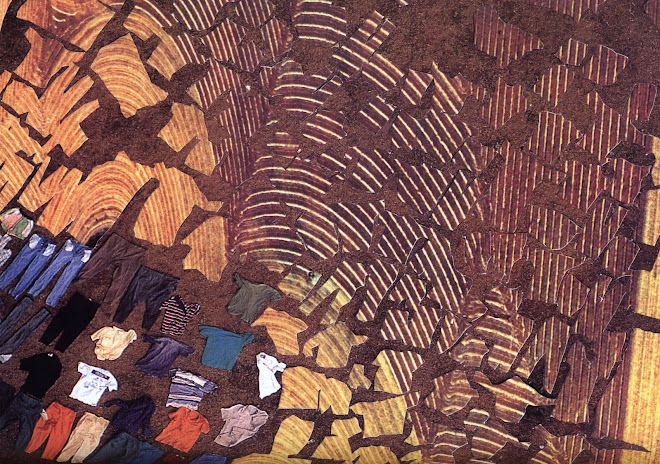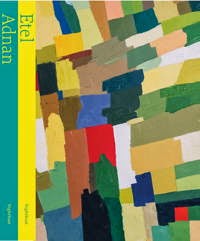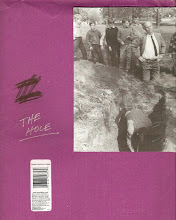
The Course of Particulars: introduction for Terry Cuddy
Tell X that speech is not dirty silence
Clarified. It is silence made still dirtier.
~ Walace Stevens
This immediacy, in the fullest sense, of relation to artworks is a function of mediation, of penetrating and encompassing experience...
~ Theodor Adorno
Since I have known Terry Cuddy, his work has existed between design, the printed book, multimedia, video, site-specific installation, live music performance (including a rock opera, *Dr. Steadfast’s Last Migraine*), sound recording, and an ongoing investigation of sound and visual image, image and text. For anyone of lesser energy and commitment such a synthesis of approaches to making art would result in a dilletantishness. With Cuddy, his variety of approach seems natural, even necessary.
Cuddy’s practice is an intensely local one that nevertheless always touches problems of global importance. Minute particulars move towards universals, extending themselves as such, twisting like an arras in this extension. In this way Cuddy is a distinctly North America ‘nominalist’ (Emerson) during a time when it is most regrettable—ethically, politically, culturally—in many ways to be one. Like Muriel Rukeyser, William Carlos Williams, Wallace Stevens, Charles Olson, Susan Howe and other Modernists before him he represents a genius of place as the local always remains in relation to other localities and individuals in his work—a world at large.
During a time of goth. revival, hyper-appropriation, virtual realities, and neo-psychadelia in popular visual art there is something unfashionable, and therefore difficult, about Cuddy’s commitment to a Modernist legacy indebted to traditions of film and video art (Hollis Frampton, James Benning, Tony Conard, Nam Juin Paik and others come to mind) as much to poetry and critical theory (Barthes, Benjamin, Adorno, Wittgenstein). After these confluent Modernist strains Cuddy returns compulsively to problems of representation, how sound, image and text synaesthetically mediate our understandings of the world as political, ethical and social beings; how, what’s more, a citizenry is inculcated in an era of American democracy’s last gasps.
In a video from 2004, Cuddy poses as the host of a home improvement program. He explains that in last week’s episode he was doing some work on the basement of a house and now he will show that work to the viewer. When, in the next scene, we find Cuddy in the basement he provides commentary on the renovations. While Cuddy talks a box appears in the center of the room. The presence of this box is unsettling in its familiarity, a text-book example of the uncanny. Before Cuddy leaves the shot ostensibly to show the viewer another room of the house he explains that he will take a photograph of the basement to document the renovation. A hand appears in the frame of the video and snaps a photograph; the photograph takes unusally long to flash, producing a stroboscopic light effect. The hand of the photographer, ominously, is wearing a white glove. The hand looks official, authoritative—like that of a doctor, or inspector. There is the pervasive sense this hand represents "the law," and that we have been at this scene of a domestic crime—a crime of interiority—many times before. In the following scene we are asked to compare the photograph just taken to another one. This later photograph is yellowed and pixellated, and shows the walls and ceiling of a room damaged by water.
When I saw Cuddy’s video for the first time I had not seen the photographs of Abu Grahib yet. I couldn’t bring myself to look at them, couldn’t make a “friend of horror” to quote Chris Marker after Marlon Brando’s Kurtz in *Apocalypse Now*. I sometimes wonder what my reaction would have been to Cuddy’s video had I seen it after encountering the Abu Grahib photos, especially that of the hooded man standing arms outspread with electric wires dangling from his chest. In the following scene of Cuddy’s video we see a television. While a program plays a hand begins to draw on the television screen with a magnet (a technique of vintage video art) slowly revealing the silhouette of the now iconic Abu Grahib prisoner. As the figure is gradually revealed a voice-over explains something about the relation between figure and ground; meanwhile the channels start to change, and eventually surf rapidly.
Through such forms of mediation—the parody of popular home improvement programs like *This Old House*, the use of historic video techniques, and appropriation of television footage—Cuddy fuses attentive and distracted attentions, diverging from both. The result is moral critique in the form of negative consciousness. The images we receive in the video are made things—that is, they are visibly produced—and Cuddy's viewer remains aware of this throughout. Beyond such awarenesses of form, Cuddy describes a haunted content. The memory of Abu Grahib as it is both affixed by indelible iconicity (the silhouetted image of the prisoner magnetized on the tv set) and erased by an attention deficient spectatorship (that of channel surfing and home improvement programs both).
As we might also say after Chris Marker's *Sans Soleil*, Cuddy makes us see “the black” in lieu of deferred contentment--"happiness". Procedure creates a blindness the origin and termini of an imaginative-critical faculty (and this is the dream of an anachronistic Modernist aesthetic practice as it collides with politics, the socially ‘real’, to this day). Form renders its contents senseless, anti-mimetic, and so produces meaning, has effects, instead. What is at stake in Cuddy’s work is finally consciousness itself as a form of action. Historical mediation via 'intermedia' as useful, if not instrumental. Playfully instrumental. Creatively didactic. A moralism that hints and points and winks.
In Cuddy’s most recent video, *The Harriet Complex*, we move among a series of scenes informing a controversy about Harriet Tubman’s commemoration in Auburn, New York, the final resting place of Tubman’s body and incidentally Cuddy’s home town. The specificity, the concise localness of Cuddy’s video, which features children performing a play about Tubman’s life in a local grammar school, a town counsel meeting where arrogant counselmen (and they are all men) argue whether an interstate that runs thru Auburn should be named after the seminal Abolition leader (in the end, an argument prevails the interstate should not be named after Tubman since this would make race an “issue” in the town, and therefore divide the citizenry along racial lines), a beautiful sequence of animated topological maps tracing Tubman’s Underground Railroad routes, and synthesized video images of town monuments commemorating Tubman, as well as photos and other documents of Tubman’s person.
Memorably, in the final scene of the video, Cuddy’s friends, family and community read letters written by locals and published in the local newspaper concerning the naming of Auburn’s highschool after Tubman (a commemorative controversy prior to debates about the naming of the interstate). During this segment each shot presents a close-up of the speaker’s mouth. That one only sees the mouths of the speakers is estranging, and distances what is said from what is seen, image from voice, ventriloquist from that thrown. That the letters are spoken by people of all different ages, genders, shades of skin, etc. provides yet another degree of reflection. The content of the letters, in their sequencing, demonstrate racial antagonism as it occurs rhetorically through the typical “letter to the editor” forum. In the very words used to state the problem of commemoration, the often absurb and illogical rhetorical arguments against the naming of the highschool, racism is revealed as banal, a quotidian evil. Unpressed by events more exigent than the seemingly apolitical decision to name a school or highway, racism remains unexamined critically and therefore abandoned as an "issue" in the town.
Through a variety of techniques and tactics Cuddy consistently returns his viewer to the fact that something is being watched, and reproduced as such (if the viewer is in fact a coproducer of aesthetic objects, and not merely subject to a work’s or author‘s authority). While certain techniques of *The Harriet Complex* would appear in loving tribute to early video art—a moment Cuddy certainly feels himself located by, and to take-up—I think they also revitalize video art’s relation to content. The content in this case is racism observed at an extraordinarily local level while extending towards problems of global import: who gets remembered, and how so on the basis of their skin-color? At a micro-political level, Cuddy’s video contains many of the problems we must still confront if racial ressentiment is to be overcome.
The key to activating this overcoming, as Cuddy’s video substantiates, is not to make speech a dirty silence clarified (to paraphrase Wallace Stevens’ poem, "The Creations of Sound"), but to make silence 'still dirtier'. That is, the more levels of mediation between a work of art and its content—the more semblance and the 'real' are related by craft—the closer we may feel to the actuality of a social problem in all of its messiness, contradiction, and the different positions of its interlocutors and actors. Or, to put it in the terms of Theodor Adorno: it is only through the mediation of artworks that social contradiction will be presented as truth *beside* political actions, consequences and effects. I feel this being *beside* as I encounter Cuddy’s work again.












No comments:
Post a Comment